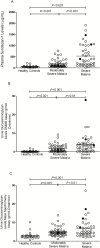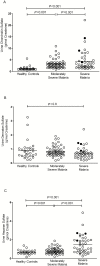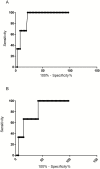Glycocalyx Breakdown Is Associated With Severe Disease and Fatal Outcome in Plasmodium falciparum Malaria
- PMID: 30753363
- PMCID: PMC6821254
- DOI: 10.1093/cid/ciz038
Glycocalyx Breakdown Is Associated With Severe Disease and Fatal Outcome in Plasmodium falciparum Malaria
Abstract
Background: Interactions between the endothelium and infected erythrocytes play a major role in the pathogenesis of falciparum malaria, with microvascular dysfunction and parasite sequestration associated with worsening outcomes. The glycocalyx is a carbohydrate-rich layer that lines the endothelium, with multiple roles in vascular homeostasis. The role of the glycocalyx in falciparum malaria and the association with disease severity has not been investigated.
Methods: We prospectively enrolled Indonesian inpatients (aged ≥18 years) with severe (SM) or moderately severe (MSM) falciparum malaria, as defined by World Health Organization criteria, and healthy controls (HCs). On enrollment, blood and urine samples were collected concurrently with measurements of vascular nitric oxide (NO) bioavailability. Urine was assayed for glycocalyx breakdown products (glycosaminoglycans) using a dimethylmethylene blue (GAG-DMMB) and liquid chromatography-tandem mass spectrometry (GAG-MS) assay.
Results: A total of 129 patients (SM = 43, MSM = 57, HC=29) were recruited. GAG-DMMB and GAG-MS (g/mol creatinine) were increased in SM (mean, 95% confidence interval: 3.98, 2.44-5.53 and 6.82, 5.19-8.44) compared to MSM patients (1.78, 1.27-2.29 and 4.87, 4.27-5.46) and HCs (0.22, 0.06-0.37 and 1.24, 0.89-1.59; P < 0.001). In SM patients, GAG-DMMB and GAG-MS were increased in those with a fatal outcome (n = 3; median, interquartile range: 6.72, 3.80-27.87 and 12.15, 7.88-17.20) compared to survivors (n = 39; 3.10, 0.46-4.5 and 4.64, 2.02-15.20; P = 0.03). Glycocalyx degradation was significantly associated with parasite biomass in both MSM (r = 0.48, GAG-DMMB and r = 0.43, GAG-MS; P < 0.001) and SM patients (r = 0.47, P = 0.002 and r = 0.33, P = 0.04) and inversely associated with endothelial NO bioavailability.
Conclusions: Increased endothelial glycocalyx breakdown is associated with severe disease and a fatal outcome in adults with falciparum malaria.
Keywords: Plasmodium falciparum; endothelium; glycocalyx; severe malaria.
© The Author(s) 2019. Published by Oxford University Press for the Infectious Diseases Society of America.
Figures



Comment in
-
Shedding of the Vascular Endothelial Glycocalyx: A Common Pathway to Severe Malaria?Clin Infect Dis. 2019 Oct 30;69(10):1721-1723. doi: 10.1093/cid/ciz043. Clin Infect Dis. 2019. PMID: 30698670 No abstract available.
Similar articles
-
Vascular Dysfunction in Malaria: Understanding the Role of the Endothelial Glycocalyx.Front Cell Dev Biol. 2021 Nov 10;9:751251. doi: 10.3389/fcell.2021.751251. eCollection 2021. Front Cell Dev Biol. 2021. PMID: 34858979 Free PMC article. Review.
-
Glycocalyx breakdown is increased in African children with cerebral and uncomplicated falciparum malaria.FASEB J. 2019 Dec;33(12):14185-14193. doi: 10.1096/fj.201901048RR. Epub 2019 Oct 26. FASEB J. 2019. PMID: 31658834 Free PMC article.
-
Degradation of endothelial glycocalyx in Tanzanian children with falciparum malaria.FASEB J. 2021 Sep;35(9):e21805. doi: 10.1096/fj.202100277RR. FASEB J. 2021. PMID: 34403544 Free PMC article.
-
Endothelial glycocalyx regulates cytoadherence in Plasmodium falciparum malaria.J R Soc Interface. 2018 Dec 21;15(149):20180773. doi: 10.1098/rsif.2018.0773. J R Soc Interface. 2018. PMID: 30958233 Free PMC article.
-
Endothelial Glycocalyx: Shedding Light on Malaria Pathogenesis.Trends Mol Med. 2016 Jun;22(6):453-457. doi: 10.1016/j.molmed.2016.04.004. Epub 2016 May 5. Trends Mol Med. 2016. PMID: 27161599 Review.
Cited by
-
Vascular Dysfunction in Malaria: Understanding the Role of the Endothelial Glycocalyx.Front Cell Dev Biol. 2021 Nov 10;9:751251. doi: 10.3389/fcell.2021.751251. eCollection 2021. Front Cell Dev Biol. 2021. PMID: 34858979 Free PMC article. Review.
-
Total parasite biomass but not peripheral parasitaemia is associated with endothelial and haematological perturbations in Plasmodium vivax patients.Elife. 2021 Sep 29;10:e71351. doi: 10.7554/eLife.71351. Elife. 2021. PMID: 34585667 Free PMC article.
-
Ulinastatin treatment mitigates glycocalyx degradation and associated with lower postoperative delirium risk in patients undergoing cardiac surgery: a multicentre observational study.Crit Care. 2025 Jan 29;29(1):52. doi: 10.1186/s13054-025-05296-9. Crit Care. 2025. PMID: 39881341 Free PMC article.
-
Preliminary assessment of serum endocan as a biomarker of disease severity in Plasmodium falciparum and Plasmodium vivax malaria.Malar J. 2025 Jul 18;24(1):236. doi: 10.1186/s12936-025-05483-7. Malar J. 2025. PMID: 40682081 Free PMC article.
-
The Glycocalyx and Its Role in Vascular Physiology and Vascular Related Diseases.Cardiovasc Eng Technol. 2021 Feb;12(1):37-71. doi: 10.1007/s13239-020-00485-9. Epub 2020 Sep 21. Cardiovasc Eng Technol. 2021. PMID: 32959164 Free PMC article. Review.
References
-
- World Health Organization. World Malaria Report. 2018.
-
- White NJ, Pukrittayakamee S, Hien TT, Faiz MA, Mokuolu OA, Dondorp AM. Malaria. Lancet 2014; 383:723–35. - PubMed

